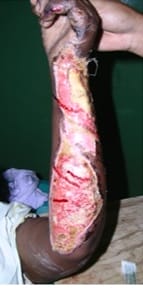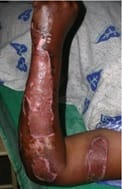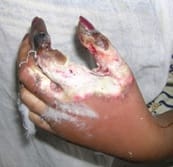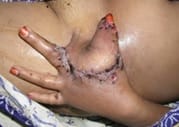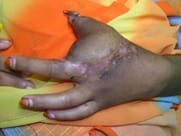Surgical Management of Snake Envenomation in India Current Perspective
Sheeja T M R.1*
DOI: https://doi.org/10.17511/ijphr.2017.i1.03
1* Rajan Sheeja T M, MS, DLO, MCh, DNB, Associate Professor, Department of Plastic and Reconstructive Surgery, Government Medical College, Kozhikode, Kerala, India.
India has reported one of the highest snake bite mortality rates in the world. It is estimated that over 5 million persons per year are bitten by snakes of whom, over 1,00,000 survivors develop severe sequelae due to local wound complications. [1] The adoption of harmful first aid practices like use of tourniquets or cutting and sucking the snake bite marks further complicates wound management. National Snake Bite Protocol has been issued in 2007, with technical support from WHO to institute proper management of snake bites [9,13]. However, there is no evidence based guidelines for local wound management in snake envenomation. The local tissue problems at the bite site were effectively managed by timely administration of anti-snake venom and other supportive management in majority of patients. Cribari et al have graded the local signs of envenomation [15]. Local tissue complications are most frequently seen with bite from Viperidae. Cytotoxic enzymes in viper venom cause proteolysis, lipolysis, blisters, necrosis and gangrene. [16,18]. Surgical management of snake bite has a significant role in preventing late sequelae and permanent disability due to snake bite wounds. The aim of surgical intervention will be radical removal of all devitalized tissues, followed by reconstructive procedures using skin grafts and flaps, to minimize functional loss and maximize rehabilitation. [21] This paper explores the pathology of a snake bite wound and compiles the accepted guidelines for wound management and also the do’s and don’ts pertaining to the bite areas following a snake bite.
Keywords: Debridement, Envenomation, Fasciotomies, Snake venom, Surgical management, Wound coverage
| Corresponding Author | How to Cite this Article | To Browse |
|---|---|---|
| , MS, DLO, MCh, DNB, Associate Professor, Department of Plastic and Reconstructive Surgery, Government Medical College, Kozhikode, Kerala, India. Email: |
Sheeja T M R. Surgical Management of Snake Envenomation in India Current Perspective. Public Health Rev Int J Public Health Res. 2017;4(1):13-19. Available From https://publichealth.medresearch.in/index.php/ijphr/article/view/58 |


 ©
© 